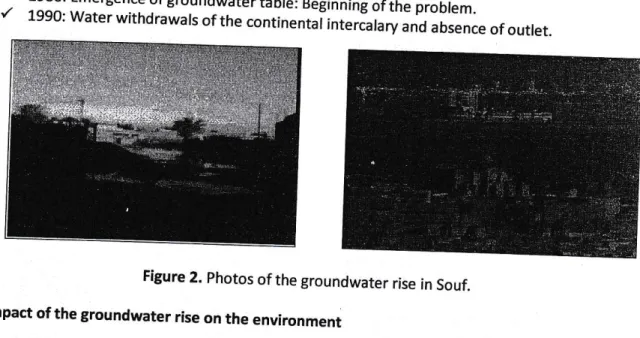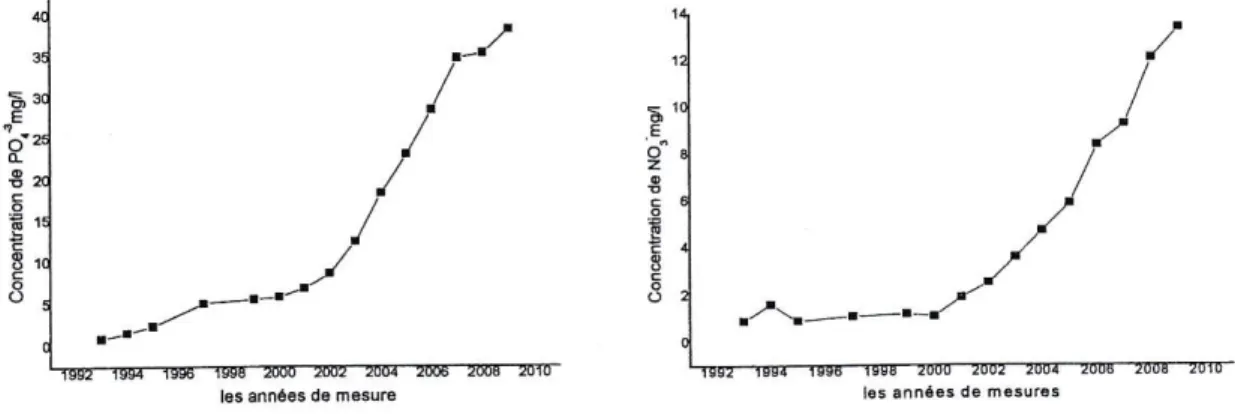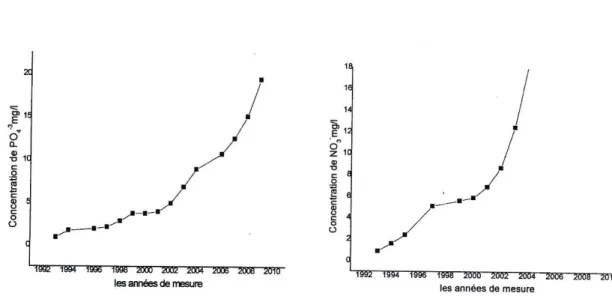WATER POTLUTION
IN
SOUF -ATGER]AN
SAHARA-Assia Meziani 1* and Soumia Meguellati2
1, 2 University
of
El-Oued, Faculty of Science and Technology, Departmentof
Hydraulic Engineering, P.O. Box 789, 39 000 El-Oued, AlgeriaE-mail: m ezia n i. assia @vahoo'fr
Abstract
lnsouf,thebadmanagementofWatersprovokedtwoimportantproblems:theascentandthe
pollutionofwaters.Thesetwoproblemscausedanecologicalunbalanceandthenegative
environmentalimpacts.lnordertosolvetheseenvironmentalproblems,somebesttechnical
solutions have been adopted: purification of waters by a âired lagoon for one time
in
5 days to 10days in order to preserve the public health and the integrity of the receiving environment, deletion of thé nuisances and the present risks of contamination
to
the tevel of the urbanized zones, drainageand evacuation
of
treated waterswithout
negative impact onthe
environment, preservationof
water resources while reusing and vâlorizing the treated waters'Keywords: Environmènt, Pollution, Groundwater rise, Souf, Sahara, Algeria'
L tntroduction
ïhe
northern Algerian sahara is characterized by an aquifer system composed oftwo
maior deep aquifers (Figure i1, l,7t i.tr are the continental lntercâlary (cl) and the complex Terminal (CT) extend over areas respectively 7O0,OO0km,
(thickness can reach 1000 m) and 350 000 km'?(the aquiferdepth varies between 100 and.5oo m), the theoretical reserves of these aquifers are estimated at nearly 60 000 billion m3 (Khadraoui,
2006)-20"8
20"N
Figurel. The North-West Sahara Aquifer System (UNESCO, 2006)' f contl""nt"t t"tercalâirerôqu-rfar
ffi
c"*peJ( re.-ioâl Aquiler(3b arêas ol abslràclion 19"o
@ area§ of abslrâcüor 2OOO
The Souf region cared as Er-oued is part
of the
northern Argerian sahara is characterized by the avairabirity
of
mobirized water.reserve dividedinto three distinct aquifers: groundwater,
Terminal complex and comprex rntercarary. The volume
.;r;;;;i;y
the
region was 393 Hm3/year, thesamples were 89 Hm3/vear and thà water
avairaiirÇ*",
zisirzvu.r
(Khadraoui, 2006).
ll. The problem
ofthe
Groundwater rise in SoufMuch has been written about
the
probrem of groundwater rise in soufwhich is attributed
to
the increased use of driflings for irrigation ana arinting;aiàiilnrrrption.
rn 1950, waters intended for human, animar consumption and for agricurture
;;;;;;;;;r"dwater.
The increase in popuration and expansion of crops has resurted in àverexptoitaiion
oîii!'.quir".,
trrr eziani ond or, 2or3r. tn the other hand, wastefurness of waters and reaks
i"
,àï*r*,
of drinking water have made the region in very erarming situation. However, ttre importani
nrimber of septic tanks and absence
of
sewerage network and also outret.caused the porution oftie
wrte.
aquifers. we can summarize theproblem ofgroundwater rise problem in 4
step.,
- - "' "
t
:?29, well reaching the Broundwater tabte and use of septic tanksr'
1970: rntense water withdrawarsof
thet"^in.i.o,npr"*
aquifer folrowed bythe
rise
of
l.
yaO: Emergence of groundwater table:Beginning of the problem.
r'
1990: water withdrawars of the**ir""a.ii"i"'.i.-r.ryina
absence or outtet.
Figure 2. photos of the groundwater
rise in Souf.
lll. lmpact of the groundwater rise on the environment The phenomenon
of
u.werinq groundwateris
a
major probrem experiencedin
many parts of theAtgerian sahara.
rhis
àrobrem-iÀb""oring inàà"iiü'iv
5lîàrs^p.,ti"rr"rry. in-Er oued
àno-ôuargra areas.
As
exampte,in
the
regionof
Et_ôuea,tË
i;iaü#r.
trve_ mainty fromfarmins and the
cuttivation of dates. This curturè is now-tn
_i,"-ui"îi,,
iiËiili,",
of groundwarer upwer-inq whose result is directly reflected in the groves crops. The.Éti.ti"J.îo*"
that thousands of parmtêes
die
each year from asphyxia (ouari and ar,2o1i),
*,"
gr*rlî.Ë
rise and the continuar degradation
of
the groundwater quality constituted serioui probËms
;il;i
"r"
of the handicaps for sustainabreDevelopment (Chebbah, 2008). The
grorni*rt".
'iri,"-
rr"r",n,,
supplied
by
the
used waters (irrigation water, industriar,nj doruii.
,r,".1
,.j-,r*
.oro,r,"
sources of these waters are the deep aquifers, followed by the appearance of water-borne diseases.
rn the other hând, the problem
of
soil sarinity is arso appeared and accompanieduv
ir,"
*i,r".r,on
of
reeds indrains
ani
pits. These areas constituted refugesfor
wira u-oar itrai;";i;rIü;.r"ge
the curtivated area.
we
note that the absence of outret and disposar or*.ri"*rtl,
in .-"1,,.,rn*.
contributed to Sround water
recharge and pollution of groundwater tabte
(n"ri"J,
lV. Water pollution of the groundwater table in Souf
Seventeen
water
samples are collectedfrom
drillings capturing groundwatertable
(Seven (07)traditional wells and drillings which some belong
to
the public sector and othersto
agricultural or rural areas), these waters were selectedto
cover the entire aquifer. The Analysis of 17 water points was made in the water Algerian laboratory of El Oued. The measured physico-chemical parametersare: The electrical conductivity, T"c, PH, cl', So4',
Hcoi,
No3, Nâ., K., Mg-, Cat.The
analysesof
Seventeenwater
samplesfrom
1992to
2010were
performedat the
samelaboratory.
The
concentrationsof
.nitrate
and
phosphatewere
determined
using
the spectrophotometric method of molecular absorption (Rodier ond ol,2OO7l, kind of DR/2500.lnterpretotion of geochemicol tacies by
faaor
onalysisThe projection of points on the diagram (Mg? Na., So4-'z/cf) gives
us
an
overviewof
the spatial distributionof
geochemical facies ingroundwater table (Figure 3).
lt
appears thatthe
most dominant facies is Sodium chloride(64.77Yo
of the
samples) andit
hasa
lesserdegree
of
Magnesium chloride facies (11.76%of the samples) and the sodium sulfate facies
(23.53%
of
the
samples).The
presenceof
Magnesium chloride and sodium sulphate can
be
the
sourceof a
base exchange occurring between Na* and Mg* (Meguellati , 2009).FiBure 3, Geochemical facies waters reports (MgYNa.,
so4'/cl)
OriEin oî the clremicol elements
The couple so4-2-
cl:
The graph shows
a
trend towards alignment points, possibly indicatinga
common origin; however, some points have excess sulfates.Other
excess chlorides.The extent
of
theexcess
of
chlorides or sulfates determines thedominant
facieswhich
is
sulphate chloridefacies (Meguellati , 2009).
Magnesium sulfate facies
t
sodium sulphate Fecies
tT
lrt
sodium chloridefacies
a
Chloride Magnesium facies
a
oa
c
aô
a (fa
Cl-The couple
Cl/so;2-
Conductivîty The diagram showsthat
all
the
pointshas
a
ratio
less
than
1,
indicating indicating dominanceof
ions
gypsumsaliferous (Meguellati , 2009).
The couple
No*4f
The graph shows an alignment
of
pointsimplying
the
same
origin
of
the
two chemical elements probably the dissolution of the halite (Nacl). However, some points havean
excessof
sodium,the
other
anexcess
of
chloride.
This
relationship confirmsthe
existence of Sodium chloridefacies (Meguellati , 2009).
The couple No*
-
Soe'zThe graphical representation of the sodium contents evolution
in
functionof
sulphate concentrationsshows
an
alignment
of
points involving the same origin of the two
chemical elements (Meguellati , 2009).
a
*
tr
t'
Figure 7. The couple Na1 Soo-2
Pollution by nitrutes and phosphates
The analysis
of
water samples H2, H4 and H5 are mentionedin
Figures 8,9
and 10,the
nitrate concentrations range between 90.5 andtot.z
mg/|, these values are considered very high becausethe Algerian norm of nitrate in water is adjusted to 45 mg/l . While the norm set by World Health
Organization " WHO" is 50 mg/l. These high values are mainly due to the frequent use of an intensive chemical fertilizers (artificial fertilizer) and natural fertilizers in agriculture. For phosphates, varied between 15 and 20 mg/|, these values are considered as indicators of pollution. WHO set the norm
of
.
t
ttt..
1}
Figure 5. The couple ClTSOq'2
*
conductivity+
/a
I
----';,)
.
tt
---".a'
-.""
t
)-'-,..
Cl-phosphate to 0.5 mg /1. This high value is due mainly by the discharge of domestic sewage in the old septic tanks; the second factor is the artificial or naturalfertilizers.
Figure B. The concentration of nitrates and phosphates in the sampling point H2 (Laouiniond a|,2009l,
Figure 9. The concentration of nitrates and phosphates in the sampling point H4 {Laouiniond al,2oo9l
Figure {o.The concêntration of nitrates and phosphates in the sampling point H5 (Laouini ond al,2oog)
Figure 11,The concentration of nitrates and phosphates in the sampling point H1 (Laouini ond o/, 2009) 6 Ê I 3 3 F 3 6 ê 3 E 3 I 16s aônéês de mê3urês
E o ,9
I
o ,E o _9 §Figure 12, The concentration of nitrates and phosphates in the sampling point H3
(Laouini ond o/, 2009)
Figure 13' concentration de nitrates et phosphates dans re point de prélèvement H6
(Laouini ond a/, 2009)
Figure 14. The concentration of nitrates and phosphates in the sampling point H7
(Laouini ond
ol
2009)les ânnées de mesure
However, the analyses
of
nitrates and phosphates concentrationsin
H1 and H3 are mentioned in Figures (11 and 12). The results show that the nitrâte varies from 15 to 20 mgll and the phosphate varies from 19.4to
38.5 mg/|. The nitrate concentration below thewHo
norm which is fixed 50 mg /1, the highest value of phosphate is considered dangerous and remarkable indicator of pollution.ln
the other
hand,the
analysisof
water samples collectedfrom
points H6 and H7 mentioned in Figures 13 and 14, concerning the measurement of nitrate given various concentrations from 40,2 to 38.5 mg/|, these values are low and also below the WHo norm. For phosphate, the values are from1.54 to 7.3 mg
/l
and they are considered high values. We note that the connection and operation of sanitation networks limit the increaseofthe
concentrations of phosphates.V. The realization of a complete system of wastewater treatment and discharge of treated water
The project aims
to
ensure the collection, transit of all polluted water andto
make their treatment before their release into the environment. We note that the purification stations collect wastewaterfrom all
citiesof
Souf networks. Forthis
purpose,four
aerated lagoontreatment
plants were distributed on area 300,000 m2. The aerated lagoon is recognized as an effective and a Technicaltreatment method, particularly for oxidizable loads (90%).
Figure 3. Purification stâtion - Aerated lagoon.
Each station of aerated lagoons is comprised of pumping station and pretreatment device (screening
and degritting), device against sandstorms and treatment of sludge by drying-beds. The Bituminous geo-membrane was selected for sealing these lagoons to take into account the typology of the land
and the specific conditions of works. The wastew€ters are first routed through a pre-treatment and
directed through channels towards sedimentation basins. The main objectives of effluents treatment
are
to
remove nuisances and current contamination in urbanized areas; discharging treated waterto
remove negative impacts on environment and
to
preserve water resources by using and enhancingthe treated water. The evacuation
of
all treated wastewater is carried out through a collector of orientation South-North to the final discharge site located 50 km north of Souf.The reuse of treated water can be beneficial because the treated water contains nutrients that are
beneficial
for
agriculture, but should be donewith
caution because the excessof
nutrients causehealth risks, agronomic and environmental risks (Baumont et al., 2005).
Vl. Conclusion
We note
that
groundwaterof
Souf has afairly
high salinity;the
predominant chemical facies isSodium chloride.
lt
is specified by very high concentrations of nitrates and phosphates in agricultural areas and high concentrationsof
phosphates especially in rural areas thenit
is recommended to make permanent monitoringof
water
qualiÿ of
wells and drillings and alsowell
located the wastewater discharges, since they are heavily laden with pollutants.Treated wastewater can be used in irrigation to satisfy most water demands, depending on the level
of
treatment, and must ensurethat
the
reclaimed water quality compliesto
the
standards ênd according to its end use.References
Baumont S., Camard J, Lefranc
A',
Franconi A.,2005. Réutilisation des eaux usées épurées: risques sanitaireset
faisabilité en Îe-de-France, rapport de recherche Réf 314579, 10 mars 2005,Observatoire régional de santé d'lle-de-France.
Benhamiaa S, 2(m9. Synthèse sur la remontée des eaux de la nappe phréatique dans la région de oued souf, étude de cas, Eco-sys 2009, Séminaire international de préservation des écosystèmes dans les zones arides, 12 à 15 Décembre, Ouargla, Algérie.
Chebbah,2OO8, Minéralisation des eaux de la nappe phréatique dans la vallée du Souf: aractéisdtion,
onEine et diir;butiod', Recueil des communications des
th
journées d'étude sur la remontée des eaux de la nappe phéatique dans la region dEl Oued, El-Oued.20 et 21 Avril, Algérie, p' 39.Khadraoui
À
2006. Khadraoui A., « Eauxet
impact environnemental dans le sahara Algérien,ressources en eau», Edition ABHS, Algérie, pp.123'
Laouini S.E, Ben Houa B, Ladjel S, Ouahrani M.R,2æ9. Evolution et évaluation de la pollution
par
les nitrateset
les phosphatesda la
nappe phréatiquede
la
valléede
oued souf (Sud-Estd'Algérie)
i
Eco-sys 2009, Séminaire international de préservation des écosystèmes dâns les zonesaridet
12 à 15 Décembre, ouargla, Algérie.Meguellati S,2oo9. Evolution du chimisme des eaux souterraines de la nappe phréatique dans
la vallee d'oued
souf;
Eco-sys 2009; Séminaire international sur la protectionet
préservation des écosystèmes sahariens. 13, 14 et 15 Décembre, Ouargla, Algérie.Meziani A, Dridi H and Kalla M,
2013.
La Remontée Et La Pollution Des Eaux Dans Le Souf -Sahara Algérien- Séminaire international sur l'hyclro-géologieet
l'environnement,5 -7
Novembre2013, Ouargla (Algérie).
ouali S,
Benaîssa Z, Belhamel M, KhellafÀ
Baddaric K, Dieddi M, 2011. lmpact of lntegratedClean Energy on the Future of the Mediterranean, "Exploitation of albian geothermal water in South
Algeria". Science directjournal, Energy Procedia 6, pp 101-109.
Remini
8,2006.
La disparition des Ghouts dans la région d'El-Oued (Algérie). Larhyss Journal,ISSN 1112 - 3580, n" 05, Juin 2006, pp.49-62.
Rodier. J., Bazin C., Broutin J. C., Chambon P., Champsaur H., Rodi L',2007' fanalyse de l'eau.
8ème édition, Dunod, Parit 1115, 1135 pp.
UNESCO, 2006. Non-renewable groundwater resources, A Suidebook on socially-sustainable management for water-policy makers, Edited by: Stephen Foster and Daniel P. Loucks.





